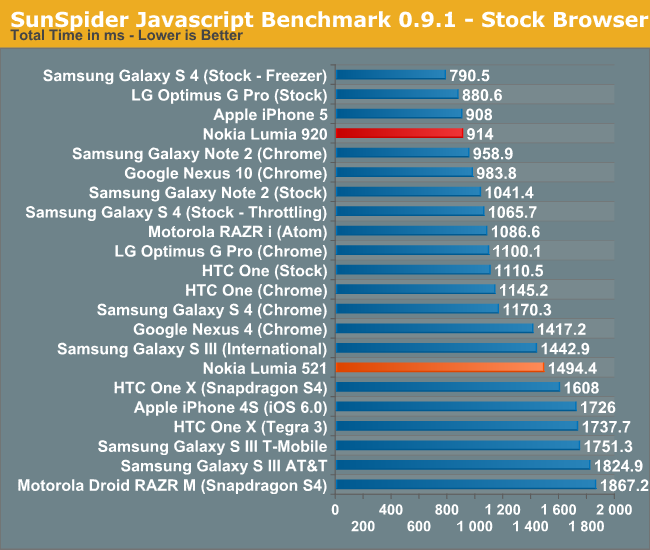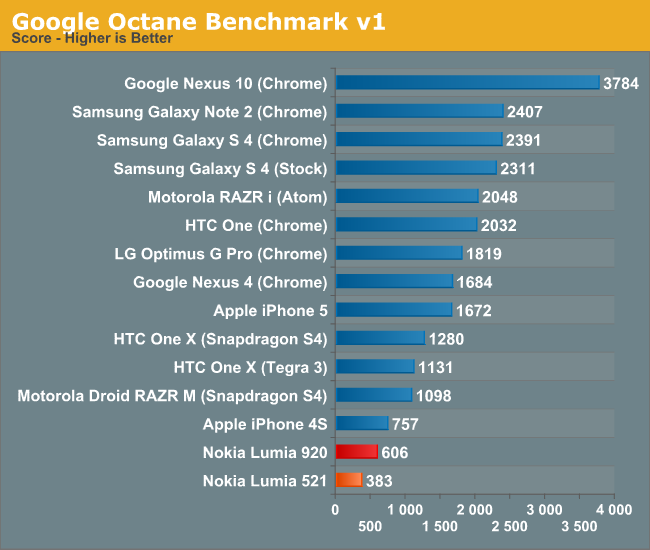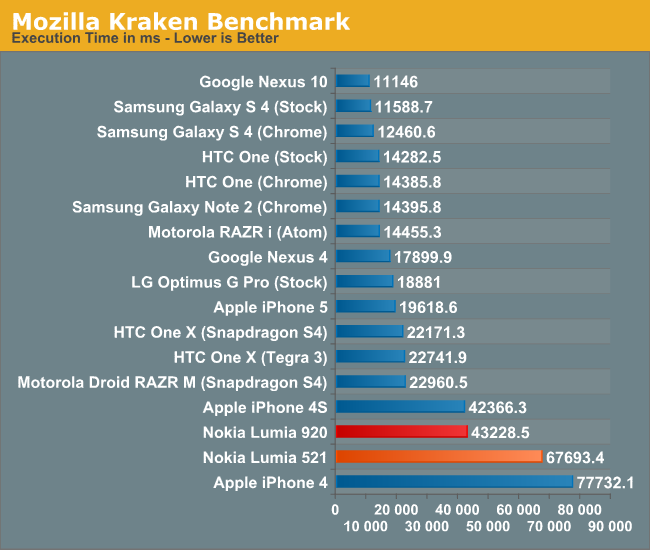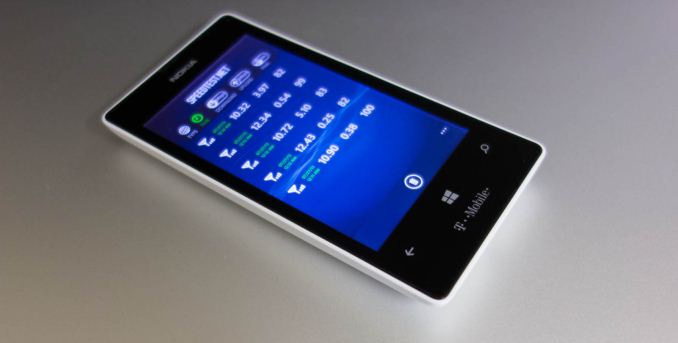Nokia Lumia 521: Quality Smartphone on an Extreme Budget
by Vivek Gowri on August 8, 2013 1:08 AM EST- Posted in
- Smartphones
- Nokia
- Mobile
- windows phone 8
- Lumia 520
- Lumia 521
Our smartphone benchmarks are centered around browser-based tests, and this is one area that really shows how far behind Internet Explorer 10 Mobile is relative to the mobile versions of Safari and Chrome. The other part of this is looking at Krait 200 at 1GHz versus the higher-clocked parts we see in the more expensive Windows Phones, which allows us to look at relative performance on the same software platform.


 Sunspider performance is actually quite good, especially compared to other Krait 200-based devices like the One X and AT&T Galaxy S3. Where it falls off is in everything else—Kraken and Octane performance is just horrendous in comparison to the modern smartphone platforms. I didn’t think it was actually possible to see numbers that high in the Kraken benchmark until I ran it a half-dozen times on my 521 review unit as well as a friend’s Lumia 920. Microsoft clearly optimized for Sunspider, as we’ve seen over the years, and while that lets them stay competitive in that one benchmark, it doesn’t really mean anything as far as having decent or even acceptable browser performance. It’s just sad.
Sunspider performance is actually quite good, especially compared to other Krait 200-based devices like the One X and AT&T Galaxy S3. Where it falls off is in everything else—Kraken and Octane performance is just horrendous in comparison to the modern smartphone platforms. I didn’t think it was actually possible to see numbers that high in the Kraken benchmark until I ran it a half-dozen times on my 521 review unit as well as a friend’s Lumia 920. Microsoft clearly optimized for Sunspider, as we’ve seen over the years, and while that lets them stay competitive in that one benchmark, it doesn’t really mean anything as far as having decent or even acceptable browser performance. It’s just sad.
Between the 920 (MSM8960, so dual-core Krait 200 @ 1.5GHz and Adreno 225) and the 521, there’s a definite performance delta. Obviously, this comes through in roughly 50% faster benchmark numbers across the board, but in day to day use, it mostly makes itself felt in slower application loading and multitasking/task switching, which is also related to having just 512MB RAM instead of the 1GB of the 920. Multitasking in Windows Phone has never really sat well with me, because it’s not really multitasking in the traditional sense—the need to completely close and rehydrate tasks makes resuming applications exceedingly slow. Microsoft has always seemed to have an issue with app load times with ARM devices—this has been true since day one with Windows Phone, and is a problem with Windows RT tablets too—so the resulting combination can really kill any desire to run more than one task on your phone at a time.
I couldn’t run GFXBench (DXBenchmark) on the 521 because it didn’t meet the 1GB RAM requirement necessary to run the benchmark. I actually wasn’t even aware that GFXBench had such a requirement in place until I tried to install it on the 521. In the grand scheme of things, I suppose it doesn’t matter too much—we’re pretty familiar with Adreno 305 by now, and it seems to be the go-to GPU for Qualcomm’s new series of dual-core Krait 200 SoCs. In a platform that deemphasizes silicon performance in the end user experience as much as Windows Phone seems to, I’m not sure that the performance delta between this and Adreno 225 makes too much of a difference, particularly with a far lower-res screen. We’re starting to see the more 3D intensive games require 1GB of memory to run, so this isn’t the device for the hardcore gamers. It does fine with the typical slate of casual games though—Fruit Ninja, Angry Birds, and the like.
The air interface is probably something you could point to and say is a bit lacking—in this day and age, dual carrier HSPA+ is almost an expectation on T-Mobile and international non-LTE devices. But honestly, you don’t end up missing it much. T-Mobile’s HSPA+ network is quite robust both in Seattle as well as in Silicon Valley, the two places I spent time testing the 521, so 10+ Mb/s was basically the norm.
I couldn’t figure out how to get the Windows Phone SpeedTest app to email a CSV of the test results, so no graphs with binned speed tests like we have on Android reviews. We’ve had a lot of experience with T-Mobile’s HSPA+ network over the years though, and it tends to be very good in most metropolitan areas. Obviously, there’s a significant jump in speed between HSPA+ and LTE, but the real-world difference between single and dual-carrier HSPA+, at least on T-Mobile, seems to be much harder to discern perceptively. The lack of DC-HSPA+ is still a bit of a disappointment, but I’m not nearly as cut up over it as I was when I saw it on the specsheet.











116 Comments
View All Comments
Death666Angel - Thursday, August 8, 2013 - link
Huh, wasn't even aware of this phone. That's pretty good value for 140€. If my wife didn't have a Chinese phone since Christmas, I'd get her one of these.Gunbuster - Thursday, August 8, 2013 - link
I love this little phone. Having jumped on the deal at HSN for $80 I could destroy this phone 6 times over and still be ahead of buying a "high end" handset.You get 90% the capabilities of better phones at a price that is over 80% lower.
kmmatney - Thursday, August 8, 2013 - link
Can you use the AT&T GoPhone version with a normal regular AT&T plan? I'm tempted to sell my 4S 32GB before before the new iPhones come out, and use this for a while.thesavvymage - Thursday, August 8, 2013 - link
yeah you just pop in the SIM and it will work since it is compatible with AT&T's frequenciesImpulses - Friday, August 9, 2013 - link
At one point in time AT&T actually flagged GoPhone IMEIs and wouldn't let you use them with pre-paid plans tho, this was a few years ago, no clue if it's still in practice.jabber - Thursday, August 8, 2013 - link
Must admit at 1:1 the pics from the 520/521 look better than the pics taken with the Nexus 4 at 1:1VivekGowri - Thursday, August 8, 2013 - link
Yeah, I wouldn't disagree with that statement.Azurael - Friday, August 9, 2013 - link
The Nexus 4's camera is notoriously bad though. I don't know what LG were thinking! It's the only thing that's even giving me thoughts about upgrading to one of this year's latest and greatest handsets. Certainly not the 400+ PPI I can't discern displays or swanky new SoCs (which are only marginally faster than the S4 Pro in the N4 but driving 1920x1080)Then I remind myself that ALL mobile cameras, regardless of how 'good' they look AS mobile cameras - Nokia Pureview being a possible excepetion - are dreadful compared to the cheapest 1/2.3" sensor-equipped compact cameras, let alone anything better with a larger sensor. In fact, when I did have a phone with a better camera (One X), I didn't use it any more than I do with the terrible camera in the N4 now.
ljlego - Thursday, August 8, 2013 - link
"Far too often, you see important functions and options pushed into random corners of the interface, buried deep in some menu."That's a pretty bold claim that I have never experienced, personally. Could you maybe provide an example of when you've found this?
Collin5 - Thursday, August 8, 2013 - link
@VivekA well done review! It is balanced and it includes a lot of useful information not found anywhere else. Thank you!
However, I also feel there are a few statements, related to multitasking and overall performance, which paint a picture with too broad a brush. Nothing critical or wrong, but something you may want to look into for future reviews of WP devices:
1)
"Multitasking in Windows Phone has never really sat well with me, because it’s not really multitasking in the traditional sense—the need to completely close and rehydrate tasks makes resuming applications exceedingly slow."
On my Lumia 520 app switching occurs instantaneously most of the time. Only when I open more apps than the device can fit into RAM, is the least frequently used app completely closed out (tombstoned). Only when switching back to a tombstoned app does the rehydration process kick in (which I agree is too lengthy). However, even the Lumia 520 can simultaneously cache two or three apps in memory, which is enough to get through most multitasking scenarios without tombstoning occurring.
Saying that "the need to completely close and rehydrate" is too much of a blanket statement. That need only exists in very specific circumstances, which some may encounter only very rarely (depending on how people use their device).
2)
"...but in day to day use, it mostly makes itself felt in slower application loading and multitasking/task switching, which is also related to having just 512MB RAM instead of the 1GB of the 920."
This could be understood to imply that having less RAM negatively impacts the time it takes to load apps AND the time it takes to task-switch between them, which is false. Having less RAM has no affect on app load times. Having less RAM also has no direct impact on the time it takes to switch between apps. Having less RAM only has an indirect affect on task-switching in the way I already mentioned... RAM capacity determines how soon apps are tombstoned. That is all. Both app load times and rehydration (basically the same thing) are directly impacted by the slower CPU however.
Certainly we can argue that the probability of a task requiring rehydration is greater on a 512 MB device, but that is what I would expect an article on Anandtech to explicitly state, instead of attributing app load performance directly to RAM capacity ;-)